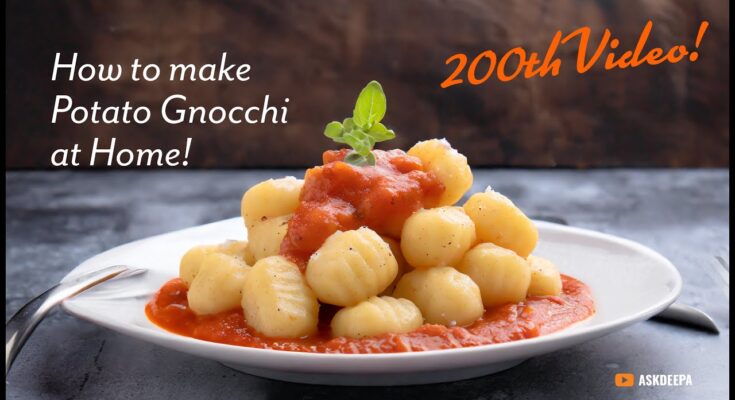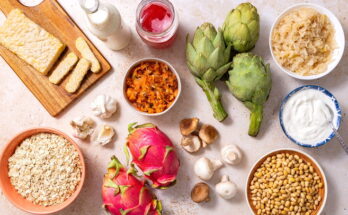Gnocchi Recipe: Gnocchi, a tender Italian dumpling, has captured the hearts of pasta and potato lovers alike. Rooted deeply in Italian cuisine, gnocchi is often referred to as a “pasta,” yet it’s a unique, pillowy creation all its own.
Traditionally made with potatoes, flour, and eggs, these delightful little bites are simple yet versatile, transforming beautifully when combined with various sauces or ingredients.
This guide will walk you through each step of making perfect gnocchi from scratch, so you can bring a touch of Italy to your kitchen.
Types of Gnocchi
While the classic version is made with potatoes, there are several other types of gnocchi enjoyed across Italy. Let’s explore a few:
- Classic Potato Gnocchi: Soft and slightly chewy, the potato version is the most common and a staple in many Italian homes.
- Ricotta Gnocchi: Made with ricotta cheese instead of potatoes, this type is lighter and creamier.
- Semolina Gnocchi (Gnocchi alla Romana): These are baked instead of boiled and use semolina flour rather than potatoes, popular in Rome.
- Regional Variations: Italy’s regions have unique gnocchi adaptations, often based on local ingredients, like chestnut flour or even pumpkin.
Ingredients Needed for Traditional Potato Gnocchi
For traditional gnocchi, you’ll need only a few ingredients:
- Potatoes: Starchy potatoes like Russet or Yukon Gold are ideal as they create a fluffier gnocchi.
- Flour: All-purpose flour works well, but be careful not to add too much.
- Egg: This binds the ingredients and provides a bit of richness.
- Salt: Essential for flavor.
Optional additions include grated Parmesan for extra flavor, or fresh herbs for a fragrant twist.
Essential Tools for Making Gnocchi
While you don’t need specialized equipment to make gnocchi, a few tools can make the process easier:
- Potato Ricer or Masher: For smooth, lump-free potatoes.
- Gnocchi Board or Fork: To create grooves that help sauces cling to the gnocchi.
- Bench Scraper: Useful for portioning the dough without sticking.
If you don’t have these tools, don’t worry; there are alternatives for each that can still yield delicious results.
Step-by-Step Gnocchi Recipe
Step 1: Preparing the Potatoes
Begin by selecting starchy potatoes, which will help ensure your gnocchi is light and fluffy. Here’s how to prepare them:
- Cooking: You can either boil or bake the potatoes. Baking helps to keep them dry, which is ideal for gnocchi.
- Peeling: Peel the potatoes after they’re cooked and slightly cooled. Hot potatoes are easier to mash without lumps.
- Mashing: Use a ricer or a masher to create a smooth texture. Avoid using a blender or food processor, as they can make the potatoes gummy.
Getting this step right is crucial, as it sets the stage for a smooth dough.
Step 2: Making the Dough
Once your potatoes are ready, it’s time to make the dough. Follow these steps carefully:
- Adding Flour: Sprinkle a little flour at a time onto your mashed potatoes.
- Incorporating the Egg: Add a beaten egg and a pinch of salt.
- Mixing: Gently combine the ingredients without overworking the dough. Overmixing can lead to dense gnocchi.
The dough should be soft, slightly sticky, but easy to handle. If it’s too sticky, sprinkle a little more flour, but use it sparingly.
Step 3: Shaping the Gnocchi
Now comes the fun part: shaping your gnocchi! Here’s how to do it:
- Rolling: Divide the dough into smaller portions and roll each into a rope, about 1/2 inch thick.
- Cutting: Use a knife or bench scraper to cut each rope into small pieces.
- Forming Ridges: Roll each piece over a gnocchi board or the back of a fork. The ridges help sauces cling to the gnocchi.
Keep the gnocchi pieces uniform in size so they cook evenly. If you prefer, you can leave them unshaped for a simpler look.
Step 4: Cooking the Gnocchi
Cooking gnocchi requires a gentle touch. Follow these steps for best results:
- Boiling: Bring a large pot of salted water to a gentle boil.
- Adding Gnocchi: Drop the gnocchi in batches; they’ll sink at first.
- Checking for Doneness: Gnocchi are ready when they float to the surface, usually within 1-2 minutes.
Use a slotted spoon to remove them as they float and avoid overcrowding the pot.
Step 5: Serving the Gnocchi
Once your gnocchi is cooked, it’s ready to be paired with a delicious sauce. Here are some classic and creative ideas for serving:
Classic Italian Sauces:
- Marinara Sauce: A simple tomato-based sauce with basil and garlic.
- Bolognese: A hearty meat sauce that pairs beautifully with gnocchi.
- Alfredo or Cream Sauce: For a rich and indulgent twist, coat your gnocchi in a creamy Alfredo sauce.
Butter and Sage Sauce: This classic Italian preparation involves melting butter in a pan, adding fresh sage leaves, and allowing them to crisp slightly. Toss the gnocchi in this sauce for a fragrant, savory dish.
Pesto: Basil pesto, with its fresh herbs and garlic, adds a bright flavor. Simply toss cooked gnocchi with pesto and top with a sprinkle of Parmesan.
Alternative Toppings and Garnishes: Try adding toasted pine nuts, grated cheese, or fresh herbs for an added layer of flavor and texture. Drizzle a little olive oil for a rich finish or add red pepper flakes for a bit of spice.
Common Mistakes to Avoid
Making gnocchi can be a delicate process, and small missteps can affect the final result. Here are some common mistakes and tips to avoid them:
- Over-flouring the Dough: Adding too much flour can make the gnocchi dense. Stick to the recipe, adding just enough flour to hold the dough together without it becoming too sticky.
- Using the Wrong Type of Potato: Starchy potatoes, like Russet or Yukon Gold, are essential for fluffy gnocchi. Waxy potatoes, like red or new potatoes, hold more water, which can lead to a gummy texture.
- Overcooking Gnocchi: Gnocchi cooks quickly, usually in about 1-2 minutes. Overcooking will make them mushy. As soon as they float to the surface, they’re ready to be removed.
- Overworking the Dough: Kneading too much can activate gluten in the flour, making the gnocchi tough. Mix the ingredients until they’re just combined for a soft, light dough.
Tips for Perfect Gnocchi Every Time
Want to elevate your gnocchi game? Here are some tips for consistently good results:
- Temperature and Humidity: Gnocchi dough is sensitive to temperature and humidity. Try to work quickly in a cool, dry environment to avoid sticky dough.
- Fine-Tuning Texture: If your dough feels too sticky, dust your hands and workspace with a small amount of flour. However, be mindful not to add too much.
- Light, Pillowy Gnocchi: Handle the dough gently and avoid over-kneading. Your gnocchi should be soft to the touch and cook up light and pillowy.
Gnocchi Storage Tips
Whether you want to prepare gnocchi ahead of time or save leftovers, here’s how to store them:
Storing Uncooked Gnocchi: Place uncooked gnocchi on a baking sheet lined with parchment paper and dusted with flour. Freeze them for 1-2 hours, then transfer them to a freezer-safe container. They can be cooked directly from frozen, without thawing.
Freezing Techniques for Long-Term Storage: Frozen gnocchi can be stored for up to 2-3 months. Just follow the same cooking instructions, adding a minute or two to the cooking time.
Reheating Cooked Gnocchi: If you have cooked gnocchi leftovers, store them in an airtight container in the refrigerator. To reheat, add them to a pan with your sauce of choice, cover, and heat on low until warmed through. Avoid microwaving, as it can make the gnocchi rubbery.
Popular Gnocchi Variations
Experimenting with gnocchi recipes can be a fun way to add variety to your meals. Here are a few popular variations:
- Spinach and Ricotta Gnocchi: For a twist on the classic, substitute spinach and ricotta for potatoes. This version is lighter, with a delicate flavor and a vibrant green color.
- Sweet Potato Gnocchi: Using sweet potatoes instead of regular potatoes adds a natural sweetness and beautiful orange color, perfect with brown butter or maple-infused sauces.
- Gluten-Free Gnocchi: If you need a gluten-free option, substitute the all-purpose flour with a gluten-free blend. Experimenting with rice flour, chickpea flour, or even almond flour can yield unique textures and flavors.
Serving Ideas and Pairings
Gnocchi can be part of a larger meal or a satisfying dish on its own. Here are some ideas for serving and pairing gnocchi:
Side Dishes:
- Garlic Bread: The garlic and butter flavors pair wonderfully with gnocchi.
- Italian Salad: A fresh, crisp salad with arugula, cherry tomatoes, and a balsamic dressing balances the richness of gnocchi.
- Grilled Vegetables: Try zucchini, bell peppers, and asparagus as a colorful, light side dish.
Wine Pairings:
- White Wine: A crisp Pinot Grigio or Chardonnay complements lighter gnocchi dishes like pesto or sage butter gnocchi.
- Red Wine: For heartier gnocchi with Bolognese or tomato sauce, opt for a medium-bodied red, like Sangiovese or Chianti.
Creating an Italian Meal:
Serve gnocchi as a main course with antipasto platters as a starter and a classic Italian dessert, like tiramisu or panna cotta, for a well-rounded Italian experience.
FAQs about Gnocchi Recipe
1. What is gnocchi?
Gnocchi are small, soft dumplings traditionally made from potatoes, flour, and eggs. They’re a classic Italian dish, often served with sauces like marinara, pesto, or browned butter.
2. How do I make gnocchi from scratch?
To make gnocchi, start by boiling and mashing potatoes, then combine them with flour and egg to form a dough. Roll the dough into ropes, cut into bite-sized pieces, and press gently with a fork to create grooves for holding sauce. Boil until they float to the top, signaling they’re done.
3. What types of sauces pair well with gnocchi?
Gnocchi pairs well with various sauces. Traditional choices include marinara, pesto, creamy Alfredo, or sage and browned butter. These options complement the texture and flavor of gnocchi beautifully.
4. Can I freeze homemade gnocchi?
Yes, you can freeze gnocchi. Lay them in a single layer on a baking sheet and freeze until solid, then transfer them to a freezer bag. Cook them directly from frozen without thawing.
5. How do I know when gnocchi is cooked?
Once gnocchi floats to the surface of boiling water, it’s ready to be drained and served. This usually takes only a few minutes, so keep an eye on it to prevent overcooking.
6. Are there variations to traditional potato gnocchi?
Yes! You can make gnocchi with ingredients like ricotta cheese, sweet potatoes, or spinach. These variations add unique flavors and textures, allowing for creative twists on the classic recipe.
Conclusion
Homemade gnocchi is a delicious way to add a touch of Italy to your kitchen. By following these steps and tips, you can make gnocchi that’s light, fluffy, and perfect for any sauce. Whether you stick to the classic potato version or experiment with variations, mastering gnocchi will open up a world of Italian cuisine that’s versatile, comforting, and always satisfying. Don’t hesitate to get creative with flavors, sauces, and toppings. With practice, making gnocchi can become a rewarding, enjoyable ritual in your kitchen.



